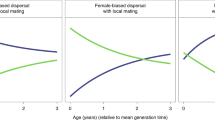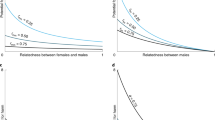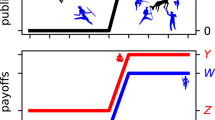Abstract
Arising from M. A. Nowak, C. E. Tarnita & E. O. Wilson Nature 466, 1057–1062 (2010)10.1038/nature09205; Nowak et al. reply
Hamilton1 described a selective process in which individuals affect kin (kin selection), developed a novel modelling strategy for it (inclusive fitness), and derived a rule to describe it (Hamilton’s rule). Nowak et al.2 assert that inclusive fitness is not the best modelling strategy, and also that its production has been “meagre”. The former may be debated by theoreticians, but the latter is simply incorrect. There is abundant evidence to demonstrate that inclusive fitness, kin selection and Hamilton’s rule have been extraordinarily productive for understanding the evolution of sociality.
This is a preview of subscription content, access via your institution
Access options
Subscribe to this journal
Receive 51 print issues and online access
$199.00 per year
only $3.90 per issue
Buy this article
- Purchase on Springer Link
- Instant access to full article PDF
Prices may be subject to local taxes which are calculated during checkout
Similar content being viewed by others
References
Hamilton, W. D. The genetical evolution of social behaviour. I–II. J. Theor. Biol. 7, 1–52 (1964)
Nowak, M. A., Tarnita, C. E. & Wilson, E. O. The evolution of eusociality. Nature 466, 1057–1062 (2010)
Griffin, A. S. & West, S. A. Kin discrimination and the benefit of helping in cooperatively breeding vertebrates. Science 302, 634–636 (2003)
Hughes, W., Oldroyd, B., Beekman, M. & Ratnieks, F. Ancestral monogamy shows kin selection is key to the evolution of eusociality. Science 320, 1213–1216 (2008)
Queller, D. C. & Strassmann, J. E. Kin selection and social insects. Bioscience 48, 165–175 (1998)
Strassmann, J. & Queller, D. Insect societies as divided organisms: the complexities of purpose and cross-purpose. Proc. Natl Acad. Sci. USA 104, 8619–8626 (2007)
Crozier, R. H. & Pamilo, P. Evolution of Social Insect Colonies: Sex Allocation and Kin Selection (Oxford Univ. Press, 1996)
Field, J. & Cant, M. A. Social stability and helping in small animal societies. Phil. Trans. R. Soc. B 364, 3181–3189 (2009)
Sachs, J. L., Mueller, U. G., Wilcox, T. P. & Bull, J. J. The evolution of cooperation. Q. Rev. Biol. 79, 135–160 (2004)
Lehmann, L. & Keller, L. The evolution of cooperation and altruism. A general framework and a classification of models. J. Evol. Biol. 19, 1365–1376 (2006)
West, S. A., Diggle, S. P., Buckling, A., Gardner, A. & Griffins, A. S. The social lives of microbes. Annu. Rev. Ecol. Evol. Syst. 38, 53–77 (2007)
Haig, D. Evolution of placental hormones. Am. J. Hum. Biol. 20, 222–223 (2008)
Wilson, E. O. in Kin Recognition in Animals (eds Fletcher, D. J. C. & Michener, C. D. ) 7–18 (Wiley, 1987)
Author information
Authors and Affiliations
Contributions
All authors conceived the project, analysed the material and wrote the paper.
Corresponding author
Ethics declarations
Competing interests
Competing financial interests: declared none.
Rights and permissions
About this article
Cite this article
Strassmann, J., Page, R., Robinson, G. et al. Kin selection and eusociality. Nature 471, E5–E6 (2011). https://doi.org/10.1038/nature09833
Received:
Accepted:
Published:
Issue Date:
DOI: https://doi.org/10.1038/nature09833
This article is cited by
-
The impacts of climate change on biodiversity loss and its remedial measures using nature based conservation approach: a global perspective
Biodiversity and Conservation (2023)
-
Cooperative partner choice in multi-level male dolphin alliances
Scientific Reports (2021)
-
Nine Levels of Explanation
Human Nature (2021)
-
The primitively social behavior of Euglossa cordata (Hymenoptera, Apidae, Euglossini): a view from the perspective of kin selection theory and models of reproductive skew
Apidologie (2017)
-
The foundress’s dilemma: group selection for cooperation among queens of the harvester ant, Pogonomyrmex californicus
Scientific Reports (2016)
Comments
By submitting a comment you agree to abide by our Terms and Community Guidelines. If you find something abusive or that does not comply with our terms or guidelines please flag it as inappropriate.



